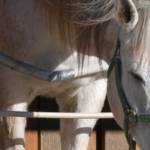Disinfecting a Stall

Routine stall cleaning goes a long way toward keeping barns clean and horses healthy, but disinfecting a stall after it has been used for foaling or housing a sick horse is much more involved. Although wood, dirt, and concrete block are all porous materials that are difficult if not impossible to sterilize in a barn setting, careful attention to disinfection technique will neutralize many disease-causing organisms.
An article prepared by the Gluck Equine Research Center at the University of Kentucky suggests these procedures:
- Remove all buckets, feeders, bedding, and mats from the stall. It is also very important to remove as much organic debris (manure, bedding, feed, dirt, and so on) as possible. Organic debris can bind or inactivate many disinfectants.
- Using a hose and garden-type sprayer, spray the walls and floor with a detergent solution. Stubborn stains may need scrubbing by hand.
- Beginning at the tops of the walls, rinse all surfaces. Remove as much water as possible by brooming water toward a drain or out the door.
- Spray disinfectant on the walls and floor and allow it to dry; do not rinse.
- Scrub all buckets, feeders, and other stall equipment such as door webbing with detergent. Rinse, then spray on disinfectant. When the equipment is dry it can be returned to the stall.
- Be sure to read the label and follow the manufacturer’s instructions. Disinfectants that are too dilute or not allowed sufficient contact time cannot be expected to be effective.
A disinfection protocol used at some other universities uses the following procedure:
- Remove all stall equipment, bedding, and manure from the stall floor and walls. With a pump sprayer, spray a mixture of 6 ounces of bleach per gallon of water on all surfaces. Rinse with clear water.
- Using a pump sprayer, spray stall surfaces with a phenolic disinfectant. Allow it to dry for 24 hours
- Clean and disinfect stall equipment as shown above.
A phenolic disinfectant will kill many microorganisms including rotavirus, a common cause of foal diarrhea. Phenol should be listed somewhere in the active ingredients. These products are available at feed stores and through catalogs. Ask a veterinarian for advice if you are not sure what type of disinfectant to use.








